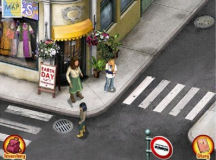Created as an alternative to Barbie
and baby dolls, the popular American Girl series of dolls and books
typically depicts an average middle class young girl growing up in various
historical eras of the United States. Julie is the ninth doll released in
the series, and her background is the 1970s time period in San Francisco.
“Julie Saves the Eagles” is the first computer game associated with the
series.
The game is rated “E” for everyone. Although the game
appears to be geared toward the eight- to ten-year-old female demographic,
there is much for the adult player to appreciate in this tale. This makes
it an ideal game for mother and daughter especially to enjoy together.
American Girl: Julie Saves the Eagles takes a look at contemporary
issues which may facilitate discussion on how those issues affect Julie
and the player herself.
The story:
Nine year old Julie Albright is essentially a curious
and warm-hearted young girl who enjoys life. Blonde, bouncy and
intellectually mature for her age, she appears to not be unduly affected
by her parent’s divorce, although she misses the old neighborhood from
which she and her mother have moved.
Through contact with a wildlife rescue sanctuary, Julie
becomes aware of the plight of injured eagles and what steps need be taken
to rehabilitate and release them to the wild. Resolving to raise money and
public awareness about the eagles, Julie cheerfully romps through a
variety of neighborhoods and meets people from all walks of life. She not
only learns about such various subjects as DDT poisoning, traditional
Chinese herbs, and rare butterflies, but also about cooperation, sharing,
and the idea that “Everything in the world is in just proportion.”
Although the philosophical bent is clearly a liberal
one, it is tempered by an understanding of the needs of those with
opposing views. For instance, while determined to make a construction
company admit their responsibility for dispossessing the eagle family from
their tree, Julie also understands the need for people to use lumber for
houses. The theme centers on balance, and the inherent good in mankind.
Julie’s world is a kind one, without criminality or ugliness in human
behavior. The strongest language used throughout the game is when Julie is
called a “tree hugger.” Rather than being offended or cowed by the label,
she stands up for herself and explains that she cares about people, but
she cares about nature too. Her prevailing good humor combined with good
common sense makes Julie’s opponents willing to hear her views and to try
to understand them.
Julie is accompanied throughout the game by her best
friend, Asian American Ivy Ling. Through this friendship, Julie has
contact with a community outside her own with different traditions and
beliefs, and this too she embraces wholeheartedly.
Although serious topics are addressed, there are still
moments of humor in the game. While unnecessary for completing tasks,
clicking the puppet head used to feed the baby eagle on various characters
elicits some interesting comments.
Julie: “I
use this puppet to feed fish to a baby eagle”.
Candyman:
“Very patriotic. And such a beautiful fragrance too.”
Mister
Kite: “ Ewww! Smells like the old can of tuna in my fridge.”
Musician:
“That puppet has got fish breath.” (Julie Saves the Eagles)
Game play and mechanics:
This is a point and click adventure game from a third
person perspective. You point and click on an area on your screen, and
Julie moves to that spot. If you prefer, you can use the arrows on the
keyboard for movement. Movement is not always smooth using either mouse or
keyboard. Occasionally it is necessary to move Julie in the opposite
direction to get her to where you need her to be. The game also stutters
somewhat in the construction area. The biggest annoyance was that Julie’s
friend Ivy is right on her heels, and on a narrow pathway this causes a
traffic jam if you decide you need to go in the opposite direction.
Your cursor will change when it passes over an area
where interaction is possible. Occasionally this was sluggish.
There is a map icon in the left hand upper corner of the
screen for instantaneous transition from one locale to another. Clicking
it will show the different destinations available to the player. At the
beginning of the game, only two such destinations are available, and as
the player progresses through the game by completing tasks, more locations
will appear. This map is a nice feature to avoid lengthy walks from area
to area. In addition to the map icon, travel can also be completed by
clicking on the bus stop icon that appears in some locations.
Julie’s inventory is shown as a backpack, and can be
accessed in the bottom left hand corner of the screen. There are many
objects to collect throughout the game. When an item is collected it goes
into the backpack, causing the backpack to sparkle. (The kid in me
especially appreciated that effect.) Once items are in inventory, a right
click of the mouse will give a description of the object – also nicely
done.
On the bottom right side of the screen is Julie’s Diary.
It includes a checklist of tasks that have been completed and those still
needing to be addressed by the player. When Julie learns important
information, this is added to the diary as well (again with accompanying
sparkle). Also a welcome touch, there is an area where the player can type
her own notes as she wishes.
Saving, loading and exiting are completed through the
icon in the right upper corner of the playing screen. You can save at any
point outside of a cut scene. There are ample saves, and each save can be
named as you wish. There is also an in-game manual which can be accessed
here (in addition to the printed manual that comes with the game).
Puzzles:
The puzzles are inventory or dialog based. Julie must
locate items on the screen, or use dialog to get an inventory item or
bring about a certain result. A few items need to be combined in inventory
to make a new item. There are no sliders, mazes, or sound puzzles. You
cannot die in the game, nor are there any reflex or action sequences.
There are two mini-games included within the game, a
Chinese coin board game and a game where you sort marbles into rows
according to color. You don’t have to win these games or even play them to
finish the main game, and you can play them at almost any time during the
game. This was a nice feature, and I enjoyed the marble game, a casual
game in itself.
Hints:
The game touts Julie’s ability to ask her mother or her
friend Ivy for hints if she’s stuck. Unfortunately, the hint system seems
to go from being helpful in the beginning of the game to not being helpful
at all. On one occasion Ivy gave me the wrong information. After a while,
asking for a hint generates a statement indicating something must have
been missed, and that you should look again. A better hint system --
especially to assist young girls unfamiliar with adventure games -- would
be an improvement for the next American Girl game.
Graphics:
The developers did a really nice job of showing detail
and animation in the screens. Though each screen is a contained area with
no panning or scrolling, it is never still, with beautiful butterflies
flitting here and there, or a kite soaring in the breeze. Characters are
animated and lifelike, for example, looking both ways down a street, using
a fan to cool themselves or displaying other lifelike mannerisms that (for
an adventure game) are unusually accurate visually. Colors are vibrant and
rich. Therefore, it is puzzling that the developers chose to limit these
beautiful renderings so you get only a small portion to see, such as a
grassy corner of a park or mountain. Combined with the excellent ambient
noises, including other people talking or playing that you can hear but
can’t see, the effect is troublesome. It feels as though you’ve gone to
the theater and are looking at the performance from behind a pillar.
Sound and music:
The ambient sounds are very well done, and change in
each area of the game. For a construction area you hear machinery, in the
park you can hear happy children’s voices, and on the basketball court you
hear sound effects associated with basketball. There isn’t much music in
the game, but with the excellent ambient sound, this really isn’t an
issue.
The voiceovers are professional and pleasing, with
appropriate accents that differ for each character so as to make each of
them unique.
Conclusion:
I applaud the developers for taking on such an important
subject as wildlife conservation, and making it a fun and interesting game
for young girls. The different characters in the game are unique, and the
story is upbeat. Some game mechanics could be improved. This is the first
game in the American Girl series, and I look forward to what the
developers will do in future games.
Grade: B
May 2008
design copyright ©
2008
GameBoomers
Group



